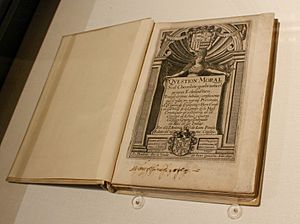Cuestión moral: si el chocolate quebranta el ayuno eclesiástico facts for kids
Cuestión moral: si el chocolate quebranta el ayuno eclesiástico (which means Whether chocolate breaks church fasting) is a book from 1636. It was written by Antonio de León Pinelo, a Spanish historian. The book talks about how chocolate drinks were used in Europe during the 1600s.
Contents
History of Chocolate and Fasting
This book was written in the 17th century, a time when chocolate became very popular in Spain. Chocolate drinks were first used by religious groups in Mexico. Later, they became popular among the richest people in European society.
Why Chocolate Caused Controversy
At that time, church leaders argued about chocolate. They thought it might be too stimulating. Because of these concerns, chocolate was not allowed in churches starting in 1681.
What the Book is About
The book looks at the different feelings and ideas people had about chocolate. Chocolate was a very exciting new drink in Madrid in the early 1600s. The author, Pinelo, shares many different opinions about chocolate. This includes views from religious thinkers who had never even tasted it! These different, often opposing, ideas make the book very interesting.
Chocolate's Role in Society
Pinelo's book explores how chocolate fit into daily life back then. According to historian Antonio Rubel García, people argued about things brought from the Americas. Some thought these new things were "imperfect" or "bad." Others defended their good qualities. Chocolate was part of this big discussion.
How Chocolate Changed
The book explains that native people in the Americas first discovered chocolate. They used it in their special ceremonies. Only their nobles and priests drank it. When the Spanish adopted chocolate, they changed it. They added things like sugar, vanilla, and cinnamon. They also made it available to everyone, not just the rich.
Why Chocolate Was Banned in Convents
Chocolate became a drink for parties and social gatherings. This led to it being banned in Carmelite convents. The religious leaders believed it went against the strict rules of monastic life. Historian M. Mercè Gras Casanova says chocolate was seen as so special and delicious that drinking it was considered wrong. It was thought to be the opposite of the simple, strict life a good Christian should live.
See also
 In Spanish: Cuestión moral: si el chocolate quebranta el ayuno eclesiástico para niños
In Spanish: Cuestión moral: si el chocolate quebranta el ayuno eclesiástico para niños



